Feed cleverhans-blog [copy] http://www.cleverhans.io/feed.xml has loading error: cURL error 22: The requested URL returned error: 404
Dialing Back to Move Forward: Why the Landline Revival Signals a Future for Privacy
On September 30, 2025, The Washington Post reported a quiet trend in Washington, D.C.: the return of landline phones among officials and journalists seeking refuge from the omnipresent surveillance of smartphones. In a recent story, NBC News spotlighted parents in Maine and Seattle who are reviving landlines for their children—creating “landline pods” so kids can connect without the addictive pull of screens or the predatory reach of social media platforms.
The post Dialing Back to Move Forward: Why the Landline Revival Signals a Future for Privacy appeared first on Purism.
Who Owns Your Digital Self?
The lawsuits now circling Apple are not just about stolen phones. They are about stolen selves—stolen data, stolen memories, stolen identities.
The post Who Owns Your Digital Self? appeared first on Purism.
Use of Generative AI in Scams
New report: “Scam GPT: GenAI and the Automation of Fraud.”
This primer maps what we currently know about generative AI’s role in scams, the communities most at risk, and the broader economic and cultural shifts that are making people more willing to take risks, more vulnerable to deception, and more likely to either perpetuate scams or fall victim to them.
AI-enhanced scams are not merely financial or technological crimes; they also exploit social vulnerabilities whether short-term, like travel, or structural, like precarious employment. This means they require social solutions in addition to technical ones. By examining how scammers are changing and...
Slim device software with systemd targets and nspawn (asg2025)
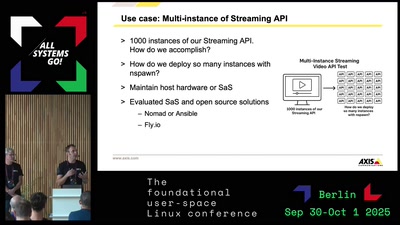
It has been 10 years since Axis Communications had a presentation at the systemd conference. Back then, we have shown how we have increased our product quality, stability and boot times by porting our platform to systemd. 10 years later, we had different challenges to keep the resource usages and boot times under control. We have started from bottom up and sliced our software for this purpose. This work also got us inspired to create virtual versions of our hardware products that we cluster deploy using systemd's nspawn. We have hundreds of engineers working on...
A terminal for operating clouds: administering S3NS with image-based NixOS (asg2025)
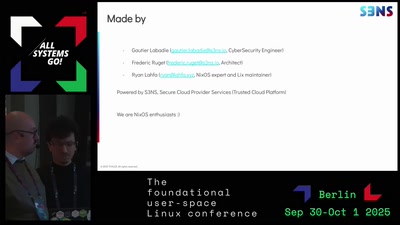
S3NS is a trusted cloud operator that self-hosts Google Cloud infrastructure in France, targeting the SecNumCloud certification, the most stringent Cloud certification framework. SecNumCloud includes strict legal and operational constraints. To manage these systems securely and reproducibly, we’ve built a family of dedicated administration terminals based on the image based philosophy. These terminals rely on NixOS semantics and draw from the ParticleOS ecosystem: systemd-repart, and dm-verity, ensuring atomic updates, full immutability of the Nix store, and verifiable integrity of the boot chain and runtime system (measured boot), while using remote attestations by TPM2 when...
container-snap: Atomic Updates from OCI Images using Podman’s Btrfs Driver (asg2025)
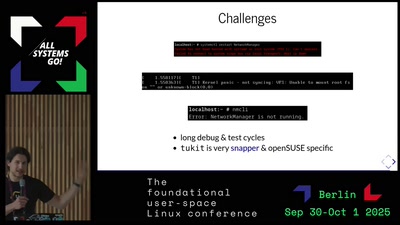
Traditional package updates using tools like RPM or Zypper can introduce risks, such as incomplete updates or accidentally breaking the running system. To overcome these challenges, we developed **container-snap**, a prototype plugin designed to deliver atomic OS updates—updates that are fully applied or rolled back without compromising the system's state. container-snap leverages OCI images as the source for updates and integrates seamlessly with openSUSE’s [tukit](https://github.com/openSUSE/transactional-update) to enable transactional OS updates. By utilizing Podman’s btrfs storage driver, it creates btrfs subvolumes directly from OCI images, allowing systems to boot from the OCI image. This approach empowers...
CentOS Proposed Updates: Bridging the Gap between development and production (asg2025)
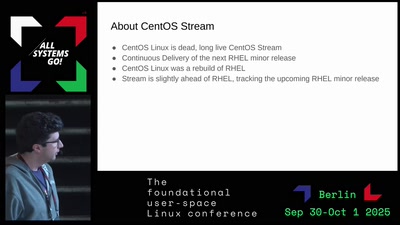
CentOS Stream is especially suited for production deployments. In these environments it's often common to develop improvements to distribution packages and want to contribute them upstream. Unfortunately, until very recently that required one to then maintain their own build and deployment pipeline for the packages, at least until the changes made their way into the distribution. CentOS Proposed Updates (CPU) SIG aims to bridge this gap - changes that have been submitted as merge requests can be built in this SIG, providing those who run Stream in production with access to needed updates while they...
Introducing ue-rs, minimal and secure rewrite of update engine in Flatcar (asg2025)
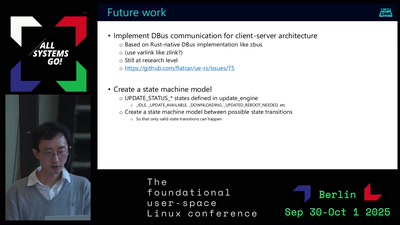
Introduce ue-rs, a fresh project that aims to be a drop-in reimplementation of update engine, written in Rust. The goal of ue-rs is to have a minimal, secure and robust implementation of update engine, required by A/B update mechanism of Flatcar Container Linux. Just like the existing update engine, it downloads OS update payloads from a Nebraska server, parses its Omaha protocol, verifies signatures, etc. This project, however, is different from the original update engine in the following aspects. First, it aims to be minimal, by reducing heavyweight legacies in the update engine. Moreover, written...
Yocto's hidden gem: OTA and seamless updates with systemd-sysupdate (asg2025)
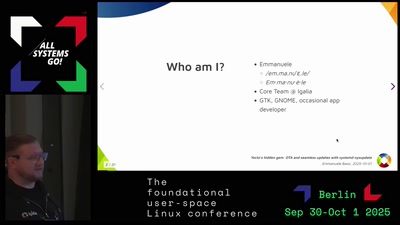
Updates are a critical piece of managing your fleet of devices. Nowadays, Yocto-based distributions can utilize layers for well-established update mechanisms. But, did you know that recent releases of Yocto already come with a simple update mechanism? Enter systemd-sysupdate: a mechanism capable of automatically discovering, downloading, and installing A/B-style updates. By combining it with tools like systemd-boot, we can turn it into a comprehensive alternative for common scenarios. In this talk, we will briefly introduce systemd-sysupdate, show how it can be integrated with your Yocto distribution, and share thoughts on how it can be improved further. Licensed to...
Forget zbus, zlink is the future of IPC in Rust (asg2025)
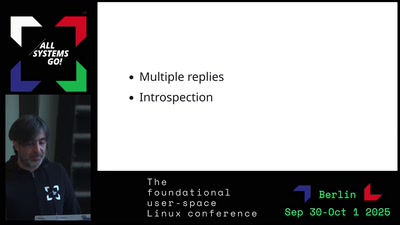
Last year, Lennart Poettering of the systemd fame, [gave a presentation](https://media.ccc.de/v/all-systems-go-2024-276-varlink-now-) at this very same conference, where he introduced Varlink, a modern yet simple IPC mechanism. He presented a case for Varlink, rather than [D-Bus](https://en.wikipedia.org/wiki/D-Bus) to be the future of Inter-process communication on Linux. As someone who works on D-Bus, I took upon myself to prove him wrong, only to find out that I achieved exactly the opposite. It didn't take long before I got convinced of his vision. Since I was largely responsible for giving the world [an easy to use D-Bus Rust library](https://crates.io/crates/zbus),...